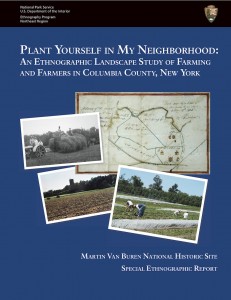NCPH 2013 Individual Consulting Award: What ethnography brings to public history
02 April 2013 – Cathy Stanton
 Editors’ Note: This series showcases the winners of the National Council on Public History’s annual awards for the best new work in the field. Today’s post is by Cathy Stanton, winner of the 2013 NCPH Excellence in Consulting Award in the individual category for “Plant Yourself in My Neighborhood: An Ethnographic Landscape Study of Farming and Farmers in Columbia County, New York.”
Editors’ Note: This series showcases the winners of the National Council on Public History’s annual awards for the best new work in the field. Today’s post is by Cathy Stanton, winner of the 2013 NCPH Excellence in Consulting Award in the individual category for “Plant Yourself in My Neighborhood: An Ethnographic Landscape Study of Farming and Farmers in Columbia County, New York.”
In 2009, Martin Van Buren National Historic Site expanded its boundaries beyond the eighth President’s post-Presidential mansion to encompass his 200+ acre farm as well. This change meant that the national park found itself in a working relationship with a modern farm that was cultivating much of the acreage. The park had previously commissioned other studies to help support its shift toward interpreting Van Buren as a gentleman farmer as well as a politician, but the Ethnographic Landscape Study [PDF] that I was hired to produce was somewhat different. It needed to connect more directly with the present day, including the contemporary agricultural economy of Columbia County, New York, where the park is located, as well as with the burgeoning “local food” movement that the farm is part of. I jumped at the chance to work on this project and found it enormously satisfying because it gave me a chance to put into practice a notion that I’d been talking about for several years around the public history community: namely, that cultural anthropology offers an extremely useful set of tools for public historians as they work with living communities and try to articulate the importance of a sense of history in the contemporary world.
One of the big advantages that I think anthropology brings to the public history table is the ability to connect historical narratives and trajectories with present-day life. This is of course a basic tenet of most public historical work—i.e. that the past matters because it’s connected to the present—but there are many things that actually work against those linkages. Historians frame their subject matter as being in the past, and they often operate in settings where institutions, funders, and audiences want things to stay past, for a variety of reasons. On the other hand, anthropologists can bring a dual vision that engages with the present while also asking about the many layers—including historical progressions and the past meanings that people have attached to things, places, and ideas—that always exist within the present moment.
Anthropologists have learned to think much more historically since the pioneering work of people like Eric Wolf, Sidney Mintz, and Marshall Sahlins in the late twentieth century. On my own blog, I’ve written about some of the specific ways that I used ethnography and ethnohistory to trace the long history of this particular farming area within the context of American agriculture in general (here’s a post that talks about some of the linkages the report makes between Van Buren’s time and the agriculture that preceded and followed it, and here’s one where I was trying to parse out what we should and should not try to ask historical research to do for us in thinking through present-day management decisions).
But it often strikes me that despite history’s “cultural turn” in the same period, historians haven’t shifted their perspective quite as lastingly or reflexively. They’ve become much better at thinking historically about culture, but they haven’t attached social scientific insights, methods, and theories to doing culture in the present—that is, to their own active participation in making culture as well as making ideas and knowledge about history. Using ethnography within public history work can be a way to put everything into the same frame and think about the resonances and dissonances among the layers. “Everything,” in this case, means the past that’s being studied and interpreted, the ideas that people have had about that past over time, and our own present-day involvement in shaping and representing those ideas and materials.
At Martin Van Buren NHS, there was plenty of both resonance and dissonance, and the park’s project of developing a working relationship with its farm neighbor has been an uneven and unfinished one. When I started the Ethnographic Landscape Study research, I naively hoped my work might provide the final piece of the map that would show how and why the two entities could work productively together. As the project went on, it became clear that there were many foundational difficulties—particularly bringing a for-profit operation into close partnership with a national park and aligning the very different goals and work habits of a big bureaucracy and a working farm that has to respond quickly to weather and market conditions. So my work shifted to include some focus on what those difficulties are and how they’re not secondary problems, but actually a part of the long history of trying to farm profitably within an industrialized and capitalist society.
I do believe there’s great value in that kind of critical look at the intersections of past and present, and again, ethnography provides a set of tools and theories that can help us with that. It’s an honor to have the study recognized with the NCPH award, and I’m excited to be continuing with this set of questions through a Working Group at this month’s conference in Ottawa as well as some future writing projects that have emerged from the Martin Van Buren project.
~ Cathy Stanton teaches in the Anthropology Department at Tufts University and practices public history in a variety of settings.



